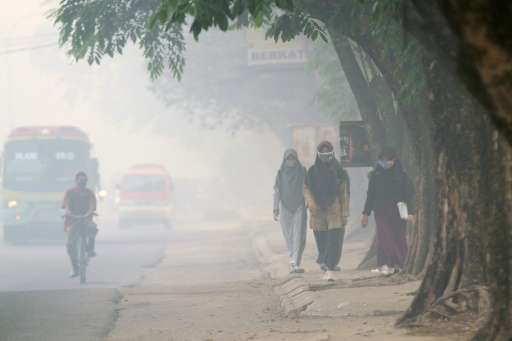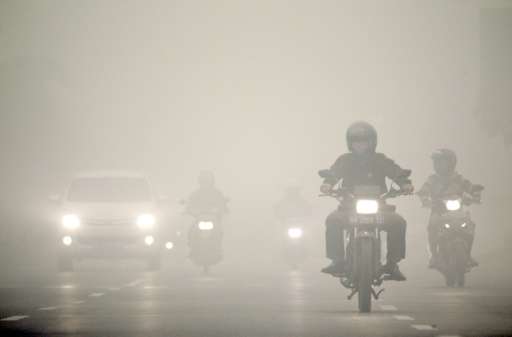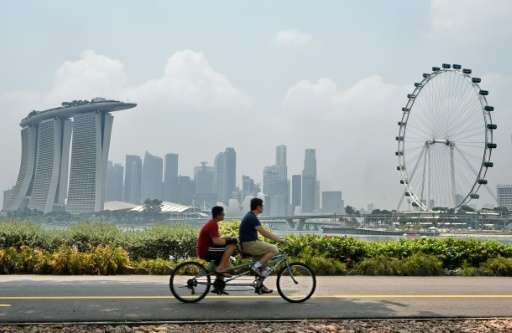People wear face masks to protect against air pollution in Palembang, Indonesia's South Sumatra province, on October 8, 2015
The haze suffocating Southeast Asia could last for another month, Malaysia's environment minister warned Monday, while a forestry expert said it could even take until year-end to clear the air.
Indonesia earlier this month agreed to accept international help after failing for weeks to douse fires from slash-and-burn farming that have shrouded angry neighbours Malaysia and Singapore in smoke.
But Malaysian Natural Resources and Environment Minister Wan Junaidi Tuanku Jaafar said those efforts will have no impact and that only the expected onset of the rainy season in November will help.
"Unless there is rain, there is no way human intervention can put out the fires," he told AFP on the sidelines of Malaysia's parliament session.
He warned that the blazes were spread across "huge areas" of Indonesia and even the multi-nation effort now under way "is not enough to put out the fires".
"We hope the rains will come in mid-November. It will be able to put out the fires," Wan Junaidi said.
The fires and resulting region-wide haze are an annual dry-season problem, but experts warn the current outbreak is on track to become the worst ever, exacerbated by tinder-dry conditions from the El Nino weather phenomenon.
Motorists travel under a heavy blanket of haze in Palangkaraya, on Indonesia's Borneo island, on October 12, 2015
More haze in the forecast
This year's dry season—and the haze—may not actually stop until year-end, about two months late, said Herry Purnomo, a scientist at the Indonesia-based Center for International Forestry Research, citing climatology data.
"It means November will not totally eliminate the haze. I believe the haze will still be happening until December," he said, adding that it will lessen.
He also said the fires were spreading throughout Indonesia, including to areas not affected in previous years as more land is opened up to palm oil plantations and other agriculture.
On Friday, Indonesia launched its biggest fire-fighting assault yet, with dozens of planes and thousands of troops battling the illegally started agricultural and forest fires concentrated in its territory on the huge islands of Sumatra and Borneo.
Thirty-two planes and helicopters—including six aircraft from Singapore, Malaysia and Australia—were deployed to back up more than 22,000 personnel on the ground.
The Singapore city skyline is seen shrouded in haze on October 9, 2015
The acrid air has sparked health alerts, sent thousands to hospitals for respiratory problems, and caused the cancellation of scores of flights and some major international events across the region.
Indonesian National Disaster Management Agency spokesman Sutopo Purwo Nugroho told AFP Monday the fires were "yet to be overcome".
Sutopo said satellite data indicated Indonesia now had more than 1,500 "hotspots", which are loosely defined as areas where fires are either burning or where conditions are ripe for blazes to break out.
"The actual number is higher as the satellite is not able to penetrate the thickness of the haze in Sumatra and (Borneo)," he added.
Malaysia, which has repeatedly ordered school closures across wide areas as a health precaution, did so again for Monday and Tuesday as pollution levels climbed well into the "unhealthy" range under the government's rating system.
Air quality in Singapore, however, improved Monday after entering "unhealthy" levels over the weekend.
© 2015 AFP


























